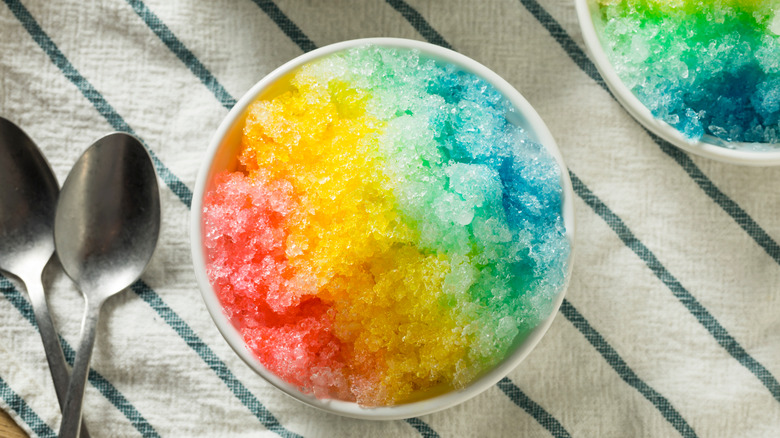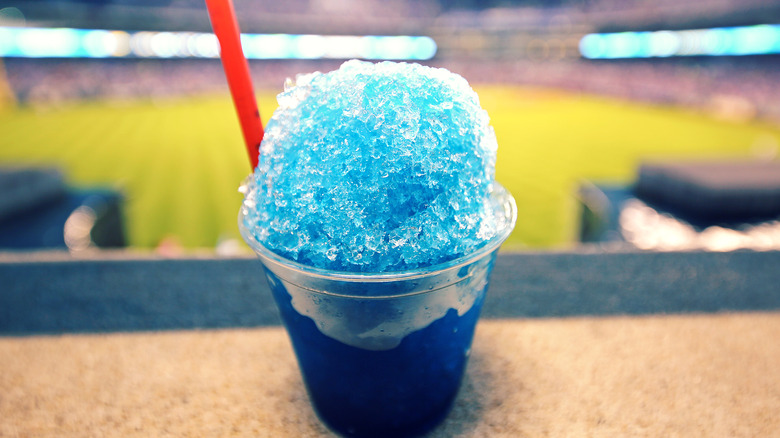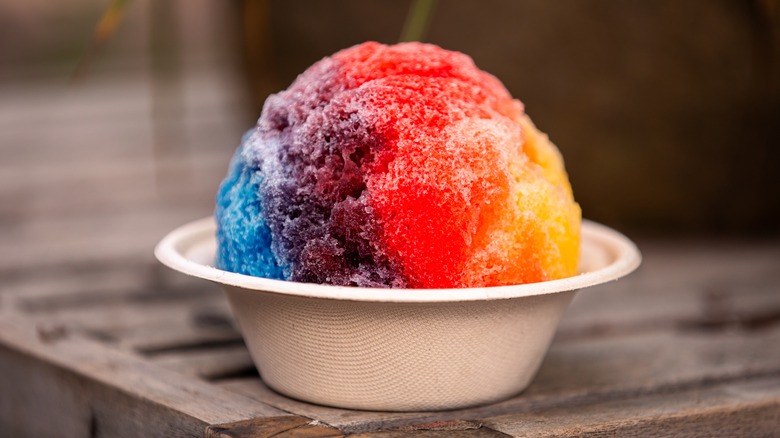The Real Difference Between Shaved Ice And Snow Cones
Like most seasons, summer has its own specific food rituals. Popular among them is a barbecue with all its regional styles, of course, and there's even a boozy watermelon salad that will bring a whole new dimension to your summer drinking game. However, frozen treats are a hot commodity come summertime, and one of the most memorable is a snow cone. There are all sorts of flavors of snow cones (there's even a pickle juice snow cone), and what's for sure is they are an icon of summer. But some may wonder, are snow cones the same as shaved ice?
The answer is no. Although there are many similarities — shaved ice and snow cones are both frozen and flavored with syrup — there is one key difference between the two, and that's texture. Shaved ice tends to be a much finer, smoother ice, almost like snow that melts very quickly in your mouth. Snow cones, meanwhile, are made up of thicker, crunchier ice that doesn't melt as fast but isn't as uniform in texture. Other things set them apart, such as the number of flavors typically on offer and where each is particularly popular, but, ultimately, the fact they feel very different when you're eating them is the biggest separator.
Snow cones and shaved ice aren't made the same way
How snow cones and shaved ice are made ultimately creates very different textures. Shaved ice is shaved to order directly off a large block of ice, creating a cup of finely-grained fluffy ice that more or less resembles snow. That means when flavorings are added, they incorporate evenly throughout the mixture, and you get a consistent texture and level of flavor throughout. To take advantage of this, shaved ice is frequently offered with a large variety of flavorings to add to their more artisanal appeal.
Snow cones, meanwhile, are made using a snow cone machine that crushes ice cubes into smaller pellets, sometimes molded into a dome shape. The advantage of snow cones is they can be scooped in advance, saving those selling it time and effort, but the drawback is their thicker, crunchier ice doesn't absorb flavorings as consistently all the way through. Snow cone machines can mass produce ice for their product well ahead of the point of sale, meaning that when a customer purchases one, the ice is simply scooped into a container rather than go through the slow shaving process used for shaved ice. This focus on cost efficiency and time-saving also means snow cones will frequently be available in a more limited range of flavors than shaved ice.
Snow cones are just snow cones, but shaved ice has many names
Shaved ice is particularly popular in a few distinct locales, where it tends to go by different names. In New Orleans, shaved ice is also known as a sno-ball or snowball and can be traced back to the 1930s. In North Carolina, you might see shaved ice referred to as "shavers." In Hawaii, shaved ice is called shave ice — they're very particular about not including the "d" — and shave ice is often topped with azuki bean paste, fruit, condensed milk, mochi, or vanilla ice cream. Whatever the name, all versions generally follow the same method: Finely shaved ice served with various flavorings — sometimes more than one.
Unlike shaved ice, snow cones are generally known as snow cones wherever you go — and you can easily find them wherever you go, too. Their ease of construction and design towards cost efficiency means they're a simpler proposition to serve anywhere, making them a favorite at many outdoor events, including baseball games and state fairs. Their toppings, in keeping with efficiency and mass production, are most commonly just flavored syrup.


